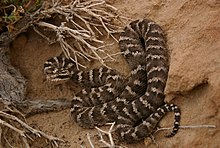Gloydius intermedius
| Gloydius intermedius | |
|---|---|

| |
| In Gobi Desert, Mongolia | |
| Scientific classification | |
| Domain: | Eukaryota |
| Kingdom: | Animalia |
| Phylum: | Chordata |
| Class: | Reptilia |
| Order: | Squamata |
| Suborder: | Serpentes |
| Family: | Viperidae |
| Genus: | Gloydius |
| Species: | G. intermedius |
| Binomial name | |
| Gloydius intermedius (Strauch, 1868) | |
| Synonyms | |
List
| |
Gloydius intermedius, or Central Asian pit viper, is a venomous species of pitviper endemic to northern Asia. Three subspecies are currently recognized, including the nominate subspecies described here.[2]
Description
Gloyd and Conant (1990) reported examining subadults and adults of G. intermedius that were 33.5–71 cm (13.2–28.0 in) in total length. Nikolsky (1916) mentioned that some individuals may reach as much as 78 cm (30.5 in) in total length. The body is relatively stout, and the snout is not upturned.[3]
The scalation includes 7 supralabial scales, 23 rows of keeled dorsal scales at midbody, 149-165 ventral scales, and 32-48 subcaudal scales.[3]
The color pattern is variable, but generally consists of 28-45 dark subquadrate dorsal blotches or crossbands that usually extend down the flanks as far as the first or second scale rows. Between these blotches are irregular light areas. A dark brown to black postorbital stripe is present, extending from the eye back to the angle of the jaw, outlined by a light line above, and by cream-colored supralabial scales below.[3]
Common names
Common names for G. intermedius include Central Asian pit viper, intermediate mamushi, Mongolian pit viper,[3] Central Asian pitviper.[4] [3]
Geographic range
G. intermedius is found in southeastern Azerbaijan, northern Iran, southern Turkmenistan, northwestern Afghanistan, southern Russia, Korea, northwestern China and Mongolia. The type locality given by Stejneger (1907) is "Governm. Irkutsk, East Siberia." Golay et al. (1993) give "Yesso (= Esso) Island, banks of Amur River and Khinggan (= Hinggan Ling) Mountain Range."[1]
Subspecies
| Subspecies[2] | Taxon author[2] | Common name[3] | Geographic range[3] |
|---|---|---|---|
| G. i. caucasicus | (Nikolsky, 1916) | Caucasian pit viper | Mostly in the mountainous regions southwest, south and southeast of the Caspian Sea. Also in southeastern Azerbaijan, southern Turkmenistan, northern Iran and extreme northwestern Afghanistan. Elevational range is from below sea level (near the southern shore of the Caspian Sea) to at least 3,000 m in the high Lar Valley in the Elburz mountains of northern Iran. |
| G. i. intermedius | (Strauch, 1868) | Central Asian pit viper | Central Asia from Kyrgyzstan, eastern Kazakhstan and Xinjiang (in China) to Mongolia and southern Siberia east to the western slopes of the Greater Khingan Mountain Range and the Torey Lakes region near the common border of China, Mongolia and Russia. |
| G. i. stejnegeri | (Rendahl, 1933) | Gobi pit viper | The edge of the Gobi Desert in southeastern Inner Mongolia south into China as far as northern Shanxi and Hebei. |
Etymology
The subspecific name, stejnegeri, is in honor of Norwegian-born American herpetologist Leonhard Stejneger.[5]
References
- ^ a b McDiarmid RW, Campbell JA, Touré TA (1999). Snake Species of the World: A Taxonomic and Geographic Reference, Volume 1. Washington, District of Columbia: Herpetologists' League. 511 pp. ISBN 1-893777-00-6 (series). ISBN 1-893777-01-4 (volume).
- ^ a b c "Gloydius intermedius". Integrated Taxonomic Information System. Retrieved 8 August 2008.
- ^ a b c d e f g Gloyd HK, Conant R (1990). Snakes of the Agkistrodon Complex: A Monographic Review. Society for the Study of Amphibians and Reptiles. 614 pp. 52 plates. LCCN 89-50342. ISBN 0-916984-20-6.
- ^ Gumprecht A, Tillack F, Orlov NL, Captain A, Ryabov S (2004). Asian Pitvipers. First Edition. Berlin: Geitje Books. 368 pp. ISBN 3-937975-00-4.
- ^ Beolens, Bo; Watkins, Michael; Grayson, Michael (2011). The Eponym Dictionary of Reptiles. Baltimore: Johns Hopkins University Press. xiii + 296 pp. ISBN 978-1-4214-0135-5. (Gloydius intermedius stejnegeri, p. 253).
External links
- Gloydius intermedius at the Reptarium.cz Reptile Database. Accessed 8 August 2008.
